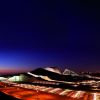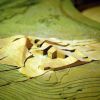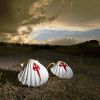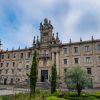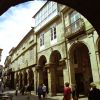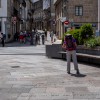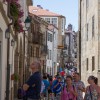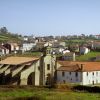- Accede I
- Regístrate I
- carrito
25. Ciudad de la Cultura de Galicia
25. Ciudad de la Cultura de Galicia
Galería de imágenes

La singularidad y el encanto de Santiago de Compostela ha ido creciendo a lo largo del tiempo con la combinación y superposición de estilos de diferentes épocas. Las intervenciones más recientes enriquecen aún más, si cabe, esa imagen acumulativa que caracteriza a la ciudad. De este modo, algunos de los mejores y más prestigiosos arquitectos del panorama nacional e internacional han dejado muestras de su obra en el espacio urbano, tal y como en el pasado hicieron los maestros canteros que llegaban a Santiago de Compostela.
Sin ninguna duda, uno de los mejores ejemplos de toda esta reciente actividad es la Cidade da Cultura de Galicia, situada en la cima del Monte Gaiás, y visible desde casi cualquier punto del trazado urbano. La idea original de este ambicioso complejo arquitectónico nace en 1999, año en que el gobierno de la Xunta de Galicia convoca un concurso internacional para seleccionar proyectos que derivasen en la construcción de un gran equipamiento cultural con diversos museos, una gran biblioteca, una hemeroteca, un teatro de la ópera, además de centros de estudio e investigación.
Por medio de un concurso de méritos, fueron seleccionadas las propuestas de doce equipos de arquitectos. De estos, cinco eran españoles, los dirigidos por Ricardo Bofill, Santiago Calatrava, Manuel Gallego, Juan Navarro Baldeweg y César Portela; uno alemán, el de Daniel Libeskind; dos franceses; encabezados por Jean Nouvel y Dominique Perrault; uno holandés, Rem Koolhaas y OMA; otro suizo, el de Annette Gigon y Mike Guyer; y, por último, dos norteamericanos, Steven Holl y Peter Eisenman, que finalmente resultó ser el ganador.
El proyecto de Eisenman refleja fielmente la talla intelectual y creativa de su autor. Este arquitecto que, tras una brillante carrera como crítico y estudioso de la arquitectura, montó su estudio con cincuenta años cumplidos, propone un edificio topográfico en el que las onduladas cubiertas de los diferentes edificios aparecen como el relieve mismo del monte Gaiás. La escala del conjunto es formidable: la línea perimetral, a vista de pájaro, simula la forma de una concha de vieira y la superficie total del recinto iguala en extensión a la del casco histórico de Santiago de Compostela. Este diálogo, intencionadamente buscado con el recinto histórico y monumental de la ciudad, se refleja también en el trazado de las principales “rúas” o calles compostelanas y sus soportales, a modo de profundas grietas que separan y por los que se accede a los diferentes volúmenes. El juego de paralelismos se completa con la presencia destacada de las dos torres que fueron situadas estratégicamente en la parte occidental del recinto. Estas dos construcciones, no obstante, son obra del arquitecto americano John Hejduk, amigo personal de Eisenman, y fueron concebidas a comienzos de los años noventa como recinto botánico para el vecino parque de Belvís. Aunque la idea original no llegó a materializarse, poco después de la muerte de Hejduk, Peter Eisenman quiso integrar el proyecto de su compañero como una parte destacada de su propuesta, a modo de homenaje póstumo.
Debido a sus dimensiones y, por qué no decirlo, al elevado coste de las obras, el proyecto estuvo desde el momento mismo de su concepción acompañado de un intenso debate social y cultural. De ahí que el destino de cada una de las piezas que estaban previstas, incluso el número total de las mismas, así como la relación de accesos desde la ciudad, vienen sufriendo reformulaciones y modificaciones constantes sobre la propuesta inicial. Muestra de ello son las intervenciones que derivaron en la construcción de diversos espacios ajardinados o en el último de los edificios construidos, dedicado al prestigioso geógrafo gallego Domingo Fontán; todos ellos vinieron a ocupar espacios inicialmente destinados a otros fines.
A lo largo de todo el año la Cidade da Cultura de Galicia cuenta con una intensa agenda cultural para todos las edades y gustos, así como un amplio programa de visitas guiadas que, junto a su valiosa arquitectura, completan la voluntad de Santiago de Compostela de convertirse en referencia destacada en el circuito cultural internacional.
Les invitamos ahora a que accedan y visiten algunos de estos espacios, como el museo, un impresionante edificio con casi 7000 metros cuadrados de superficie que habitualmente acoge grandes exposiciones, o la gran biblioteca, cuya finalidad es la de recoger y conservar todo el patrimonio bibliográfico de Galicia; a que disfruten de largos y tranquilos paseos por los senderos del Bosque de Galicia o por el Parque da Lagoa, un cinturón verde con más de 30 hectáreas de especies autóctonas que rodea todo el complejo, o que simplemente se sienten en alguno de los bancos y gocen del entorno natural y de unas vistas panorámicas inmejorables.








